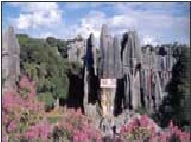|
 The
Stone Forest, one of
Chinaís most famous
scenic spots and known
as "the most fantastic
scenery under heaven",
is located in the Lunan
Autonomous County of Yi
Nationality, about 75
miles southeast of
Kunming. It in fact is a
massive collection of
grey limestone pillars,
split by rain water and
eroded to their present
fanciful forms. Covering
a total area of 350
square kilometer, it
includes the big and
small stone forests, and
other scenic spots such
as the "Moon Lake", "Dadie
Waterfall", and
"Subterranean Stone
Forest in Zhiyun Cave".
Since the Ming dynasty,
Stone Forest has long
been one of the most
famous scenic spots in
China. The
Stone Forest, one of
Chinaís most famous
scenic spots and known
as "the most fantastic
scenery under heaven",
is located in the Lunan
Autonomous County of Yi
Nationality, about 75
miles southeast of
Kunming. It in fact is a
massive collection of
grey limestone pillars,
split by rain water and
eroded to their present
fanciful forms. Covering
a total area of 350
square kilometer, it
includes the big and
small stone forests, and
other scenic spots such
as the "Moon Lake", "Dadie
Waterfall", and
"Subterranean Stone
Forest in Zhiyun Cave".
Since the Ming dynasty,
Stone Forest has long
been one of the most
famous scenic spots in
China.
Taking the shapes of
pagodas, walls, pillars,
ganodermas, swords or
animals, a huge number
of vertically carved,
fantastically shaped
limestone pillars
scattered here and
there, in which one of
them is engraved with
two big words "Stone
Forest", forming a
marvelous landscape.
Range between 6 ft and
98 ft in the height,
these pillars, from a
distance, look like a
dense forest. No wonder
that strolling among
them, one would trow
that he is in a maze.
Major scenic spots in
Stone Forest include
Sword Peak Pond, Jade
Lake, Lotus Blossom
Peak, Big Stone Forest,
Naigu Stone Forest,
Dadie Waterfall, Zhiyun
Cave, Qifeng Cave, Long
Lake, Moon Lake, and
Peak View Pavilion.
As soon as the visitors
enter the forest, the
"Sword Peak Pond" would
burst into your
eyesight, with its
purely jadeite-colored
water. Leaning against
the red railing by the
pond, one can enjoy the
peculiar sight of the
countless stone peaks
assuming a thousand
different shapes, all
fanciful and
picturesque, and the
goldfish leisurely
wagging the tail in the
pond. Walking on, the
numerous fantastic stone
peaks, rock pillars,
stone flowers, rock
levels, and rock flows
which appear in
succession would make
you believe that you are
in a kingdom which only
exist in fairy tales.
The splendor of this
place is enhanced by
another feature, that
is, the custom of the
local Sani peope, which
is a branch of the Yi
nationality. Sani people
are industrious,
unconstrained and
hospitable and all Sani
girls are experts at
spinning, weaving and
embroidering. The Sani
people, especially the
young people, are very
good at singing and
dancing. Each day at
sunset, boys and girls
would gather at the
village platform and
colorful programs would
be held there. The boys
play the three-stringed
plucked instruments
while the girls dance
enthusiastically with
the drumbeats. If lucky
enough, you would be
invite to join the
dancing and get a good
guide at the same time.
The most attractive
festival of Sani people
is the Torch Festival
which comes every lunar
year on June 24 th. On
that day the entire
Stone Forest is
permeated with a
festival atmosphere.
Traditional performances
like wrestling,
bull-fighting are shown
in the forest. When the
land is enveloped in a
curtain of night, young
men, holding torches in
their hands run after
girls to propose
marriage in the light of
colored lanterns. This
tradition continues for
many years and till
today it has more
fascination for visitors
than ever.
About the formations of
stone forest, legend
goes that the immortals
smashed a mountain into
a labyrinth for lovers
seeking some privacy.
While about this unique
phenomenon of Stone
Forest, modern science
gives a reasonable
answer. According to
geologistís studies and
verifications, the Stone
Forest was a vast
expanse of sea in the
carboniferous period of
Paleozoic era which
commenced 270 million
years ago. Later the sea
receded due to the
movement of the earthís
crust and the limestones
deposited on the seabed
rise up, hence formed
the land. Eons of
weathering and erosion
dissolved the stone and
broadened the fissures,
and finally molded them
into groups of pillars,
which from a distance
resemble a dense mass of
trees. |



